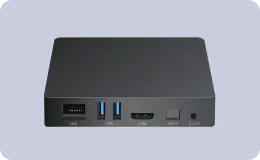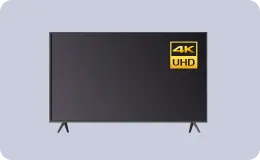Best Digital Signage Players for 2024: From Cheap to Enterprise Systems
WRITTEN BY: TelemetryTV, 02-01-2024
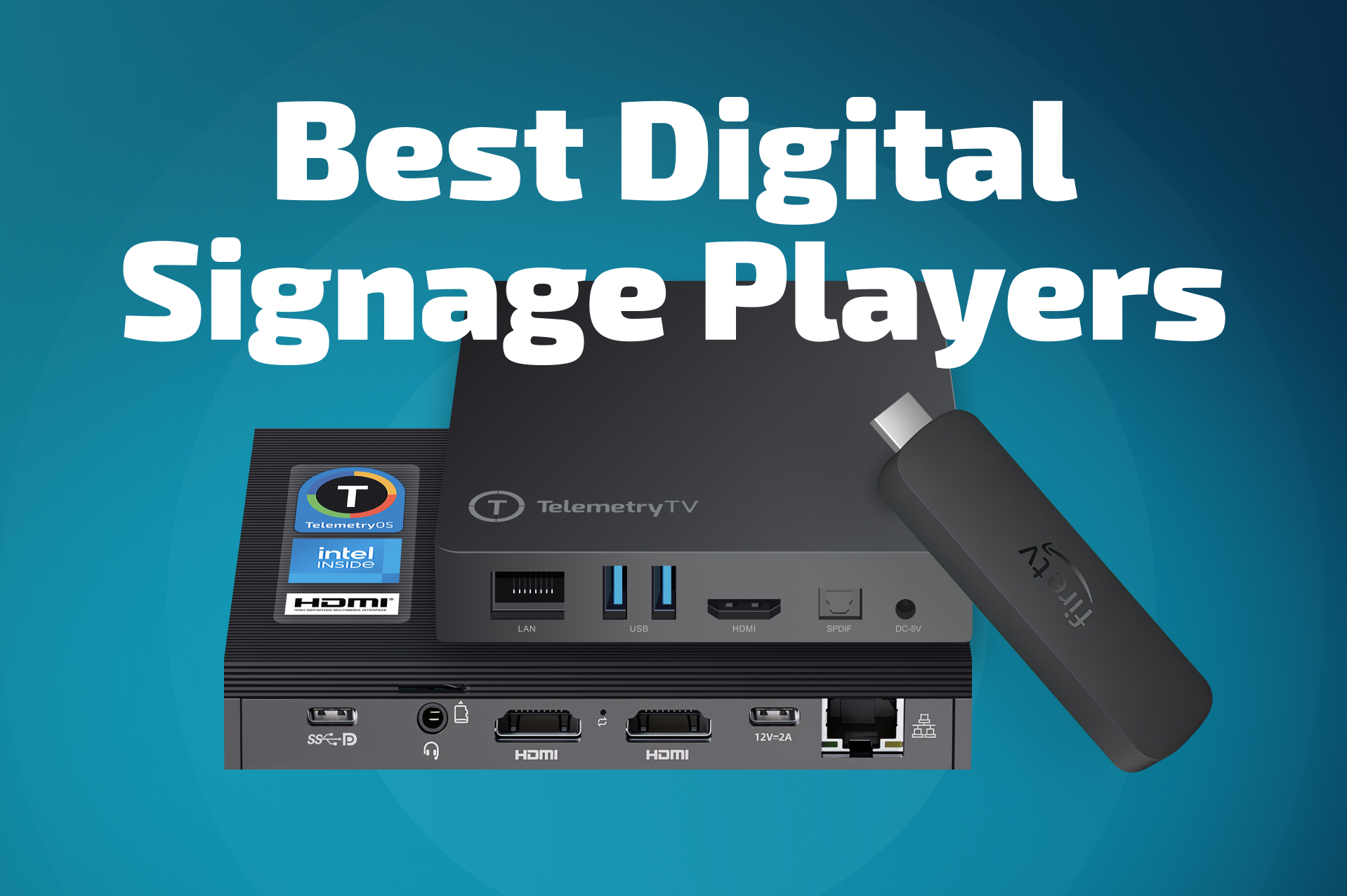
Introduction to Digital Signage Players
In today's visual landscape, digital signage plays a crucial role. It can be seen in vibrant video walls in shopping malls, digital bulletin boards in education, touch screen kiosks in QSR, and corporate screens displaying business metrics.
If you're new to digital signage, the first step is to invest in three key components: a digital signage software solution, screens, and a media player for each display. However, with the rapid evolution of digital signage technology, it can be challenging to determine the best hardware options.
Since its founding in 2015, TelemetryTV has tested over 300 digital signage players on all platforms. We can now share our top 10 picks for 2024, providing detailed insights into the advantages, limitations, and potential of each hardware option. This guide aims to to reduce your research time so that you can concentrate on strategic digital signage deployment and content creation.
Summary Table for Choosing a Digital Signage Player
For a quick recommendation on digital signage media players in 2024, refer to the summary table below. If you need more detailed information about each option, continue reading. And if you are also looking for screens, don't miss our comprehensive guide on the top digital signage displays.
| Category | Player | Best For | Price | Purchase |
|---|---|---|---|---|
| Enterprise | TelemetryOS Box | 24/7 Large-Scale Networks | $$$ | Link |
| Android | TelemetryTV Droid-1 | Android-Based Network Setups | $$ | Link |
| Best Cheap | Amazon Fire TV Stick | Entry Level Signage | $ | Link |
| RPi | Raspberry Pi 5 | Small-Scale Setups | $$ | Link |
| Chromebox | ASUS Chromebox 5 | High-Performance Chrome Setups | $$$ | Link |
| Kiosk | AOPEN cTILE 22 II | Interactive Kiosk Solutions | $$$ | Link |
| Windows | Intel® NUC Pro | High-Performance Windows Setups | $$$$ | Link |
| Linux | Intel® NUC Pro | High-Performance Linux Setups | $$$$ | Link |
| Apple | Mac mini | High-Performance Apple Setups | $$$$ | Link |
| All-in-One | Amazon Fire TV | Internal Communications | $$ | Link |
| The Most Advanced Digital Signage OS | ||||
| Cloud-Based Digital Signage Software | ||||
Top Enterprise-Grade Digital Signage Player
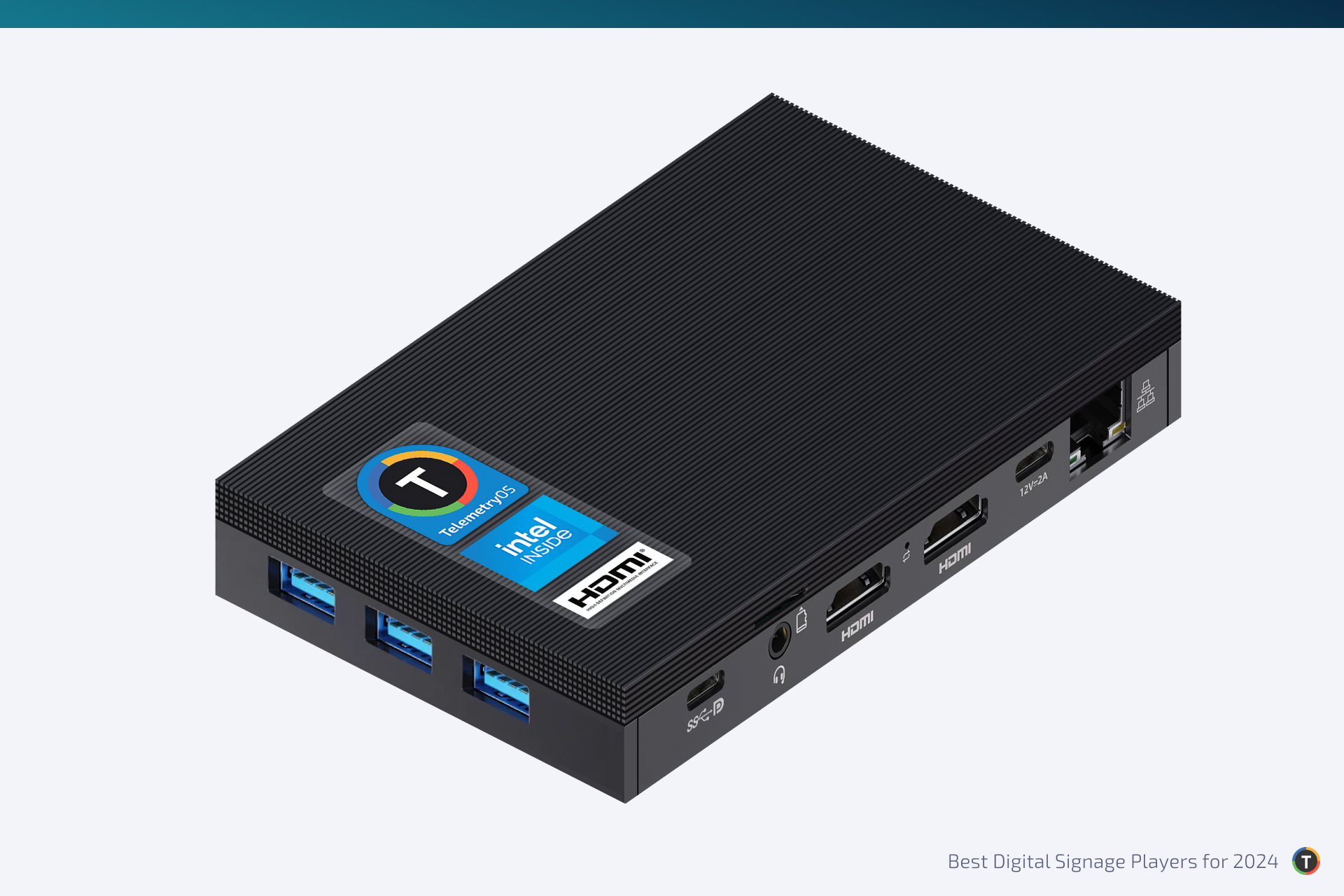
Top choice: TelemetryOS Box
TelemetryOS Box is the ideal choice for demanding customer operations, especially in customer-facing digital signage environments such as retail, QSR, banking, healthcare, and more. This player is known for its resilience and high performance, making it suitable for continuous 24/7 usage. Its efficiency is attributed to its purpose-built operating system, TelemetryOS.
TelemetryOS is based on the LTS version of Ubuntu 22, supported through 2030 and beyond, offering long-term usability without the need for forced upgrades or concerns about artificial obsolescence. It has been streamlined to include only the key components necessary for running digital signage content with optimal performance. This ensures the lowest total cost of ownership in the market by reducing truck rolls and guarantees high-value performance.
The player is powered by a modern and powerful Intel processor and offers dual HDMI ports and one USB-C display ports, each supporting 4K video. This performance is complemented by a significant storage capacity of 128GB eMMC, ensuring ample space for high-resolution content and multimedia files. Connectivity is a strong suit of the TelemetryOS Box, offering options like WiFi Dual Band, Bluetooth, a Gigabit LAN port, and multiple USB 3.0 ports. Such a comprehensive suite of connectivity options ensures seamless integration into diverse digital signage networks.
When used together with TelemetryTV digital signage software, the device offers streamlined device management and minimal maintenance model, which significantly reduces downtime and maintenance hours. With a focus on ease of use and security, TelemetryTV offers a turnkey USB and configuration-template device provisioning workflow, allowing rapid deployment at scale.
Pros:
- High performance and stability, ideal for 24/7 customer-facing digital signage.
- Extensive connectivity options, including three 4K outputs and dual-band WiFi.
- Large storage capacity and efficient device management, reducing downtime and maintenance efforts.
Cons:
- Higher price point, however rapidly covered with one of the lowest total cost of ownerships.
- The compact form factor may require additional mounting solutions in certain installations.
- Advanced features and capabilities might be overkill for smaller, less demanding digital signage applications.
In conclusion, TelemetryOS Box emerges as a formidable choice for businesses looking for a high-performing, reliable digital signage player, especially in scenarios where customer engagement and continuous operation are critical.
Pricing Tier: $$$
Purchase Link: TelemetryOS Box on Amazon
Best Android Digital Signage Player

Top choice: TelemetryTV Droid-1
TelemetryTV Droid-1 emerges as a noteworthy contender, especially for enterprises requiring a cost-effective, mid-performance solution. Running on Android 11, the Droid-1 player is tailored for those who prefer an Android-based platform for their signage needs.
The Droid-1 is best suited for businesses looking for a device that strikes a balance between performance and affordability. Its quad-core processor ensure smooth operation for simplistic digital signage applications and generic content. The device supports 4K video output and is equipped with ample connectivity options, including USB 3.0, USB 2.0, and Ethernet ports, catering to various digital signage setups. Storage-wise, the device comes with 32GB eMMC, which is adequate for applications, photos, and videos, but might require external storage for more demanding content.
The Droid-1's strongest features include its robust processor, ensuring smooth playback and multitasking capabilities. The inclusion of Android 11 provides access to a vast range of apps and customization options, making it a versatile choice for varied digital signage needs. Additionally, the device's 4K resolution support ensures that your content is displayed with clarity and impact.
Pros:
- Cost-effective: The Droid-1 is an affordable option for Android-based signage network, providing a balance between functionality and budget.
- Android Flexibility: Running on Android 11, it offers a familiar interface and access to numerous apps, including the native TelemetryTV player application.
- Good Connectivity: With multiple USB ports and Ethernet, it ensures easy integration into various signage setups.
Cons:
- Limited Performance: It may fall short for more enterprise-grade applications demanding for computing recourse.
- Limited Storage: While 32GB of storage is adequate for applications, photos, and videos, it might require external storage for more demanding content.
Priced at a competitive point, the TelemetryTV Droid-1 is an excellent choice for small businesses needing a mid-range digital signage player.
Pricing Tier: $$
Purchase Link: TelemetryTV Droid-1
Best Cheap Digital Signage Player
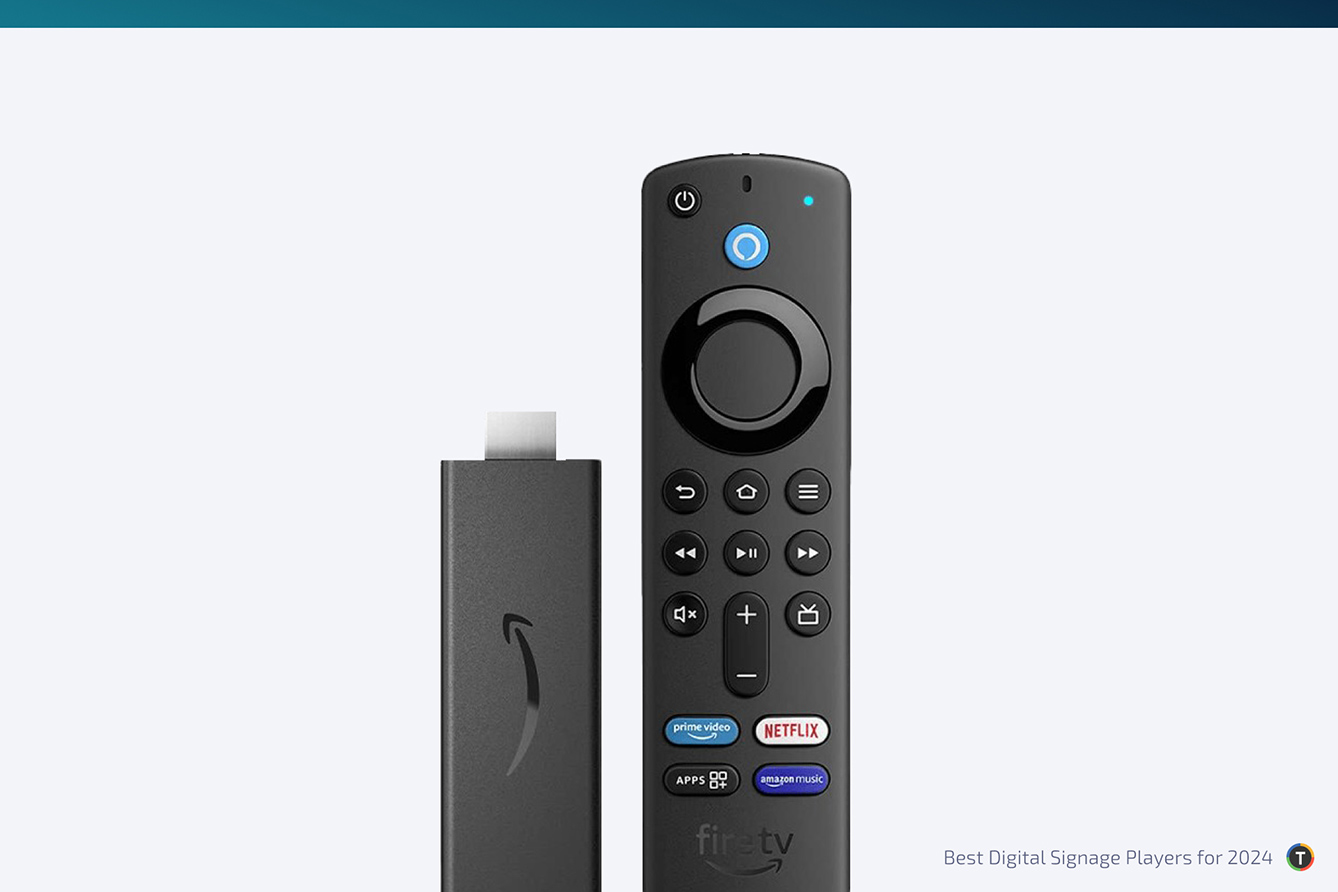
Top choice: Amazon Fire TV Stick
In the realm of digital signage, particularly for small-scale, cost-sensitive business applications, the FireTV Stick Lite and FireTV Stick stand out as pragmatic choices. These devices are designed with an eye towards businesses where rapid deployment and budget are key considerations, making them particularly suited for non-customer-facing signage scenarios, such as internal communication displays or informational screens in back-office environments.
The FireTV Stick Lite, with its 1080p output capability, quad-core 1.7 GHz processor, and Dolby Audio via pass-through HDMI, represents a cost-effective solution for businesses. It's particularly beneficial for scenarios where initial investment and swift setup are paramount. The Lite version, however, lacks certain features like advanced TV controls, which may limit its functionality in more dynamic signage setups. Its design allows for easy concealment behind screens, minimizing physical footprint and installation complexity.
Conversely, the FireTV Stick, while sharing many specifications with the Lite, includes an enhanced remote with additional TV controls, offering a slight edge in usability and integration. This makes it a more suitable option for businesses looking for a balance between cost-efficiency and feature richness. However, it's important to note that neither device is intended for continuous 24/7 operation, which could lead to higher Total Cost of Ownership (TCO) due to potential downtimes and the need for occasional maintenance.
Pros:
- Cost-effective solutions suitable for small-scale, budget-conscious business applications.
- Compact and unobtrusive design, facilitating easy installation and minimal space usage.
- Sufficient processing power and display capabilities for basic digital signage needs.
Cons:
- Not designed for continuous 24/7 operation, potentially leading to higher downtime and maintenance costs.
- Limited advanced features and TV controls (especially in the Lite version), which might restrict functionality in diverse setups.
- Potential higher TCO in scenarios requiring frequent relocations or in diverse locations due to the need for maintenance and system checks.
In summary, both the FireTV Stick Lite and FireTV Stick offer viable solutions for businesses seeking affordable and efficient digital signage players for limited-scale deployments. The choice between the two would largely depend on the specific requirements of the business, balancing cost against desired functionalities.
Pricing Tier: $
Purchase Links: FireTV Stick Lite on Amazon and FireTV Stick on Amazon
Best Raspberry Pi Digital Signage Player
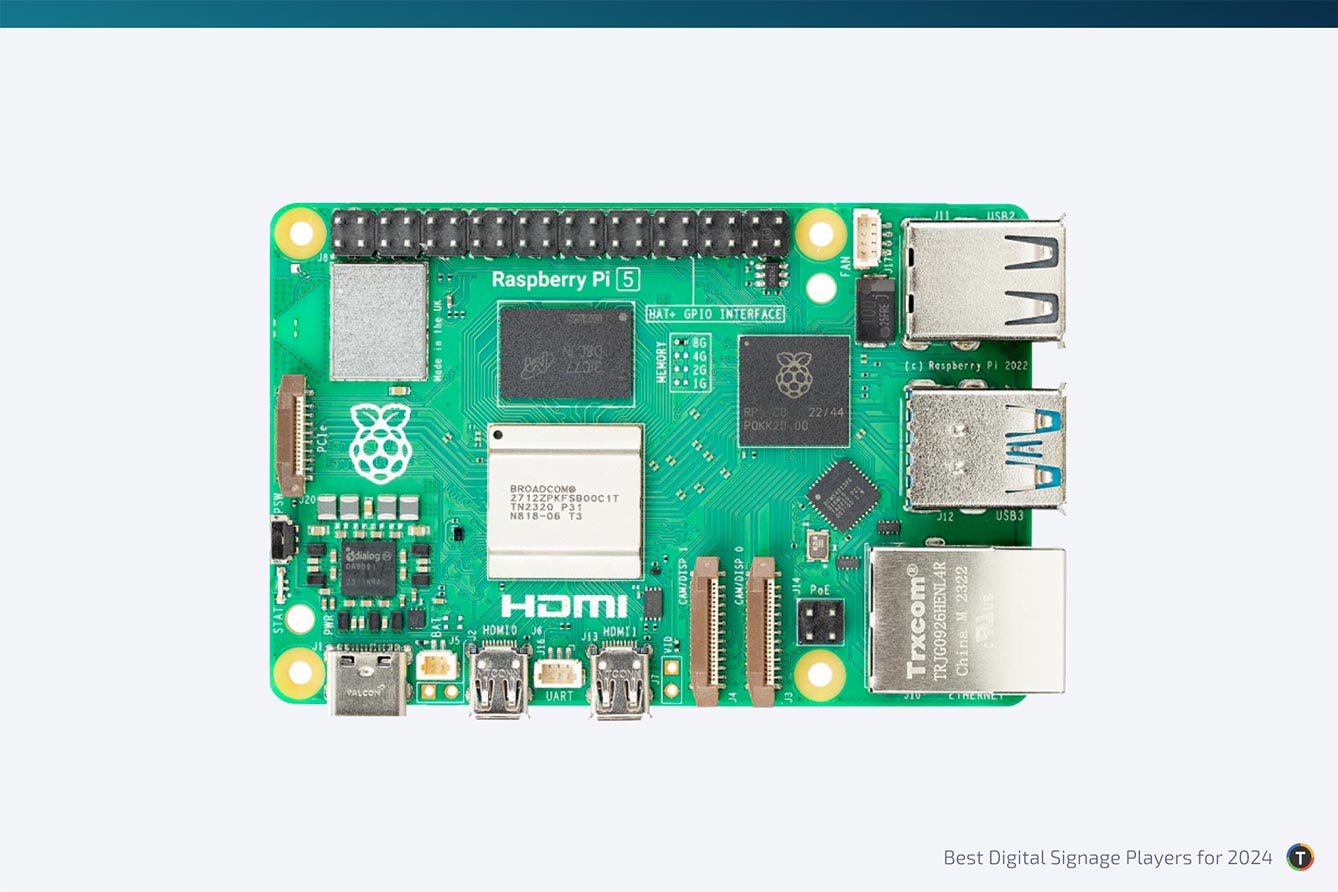
Top choice: Raspberry Pi 5
The next evolution of the Raspberry Pi is finally here. The Raspberry Pi 5 emerges as an outstanding entry-level option for simple digital signage, especially in internal communications scenarios, striking a balance between cost-efficiency and performance. This compact, credit card-sized computer offers a significant upgrade in capabilities, making it well-suited for displaying images, videos, presentations, and running basic digital signage applications.
At the heart of the Raspberry Pi 5 is the quad-core ARM processor. This processor, alongside RAM options of 4GB and 8GB, provides a performance boost up to three times that of its predecessor, the Raspberry Pi 4. This increased power ensures smoother operation of digital signage content. Additionally, its dual 4Kp60 HDMI display outputs with HDR support allow for multi-screen setups, essential for engaging digital signage displays.
The Raspberry Pi 5 offers a microSD card slot, supporting high-speed mode, which can be utilized for additional storage solutions. This flexibility in storage allows businesses to store and display high-resolution multimedia files effortlessly. Moreover, the device's compact size and energy efficiency make it ideal for deployments in various locations, including space-constrained offices, meeting rooms, and other environments.
The Raspberry Pi 5 is highly cost-effective, offering an affordable solution compared to other commercial digital signage hardware. The device's versatility and compactness enable easy installation and customization to fit specific signage needs. Additionally, the Raspberry Pi platform supports a wide range of operating systems, including TelemetryOS-ready, which offers additional benefits when managing multi-device setups.
Pros:
- Affordability: Raspberry Pi 5 is budget-friendly, providing a cost-effective solution for digital signage.
- Performance Upgrade: With its quad-core processor and up to 8GB RAM, it offers a substantial performance increase, suitable for various digital signage applications.
- Energy Efficiency: Its low power consumption makes it an eco-friendly choice, ideal for long-term use in digital signage.
Cons:
- Limited Processing Power for Complex Tasks: While suitable for basic applications, it may struggle with more demanding digital signage tasks.
- Storage Limitations: Reliance on microSD cards and external storage may be limiting for extensive multimedia content.
- Regular Maintenance Required: To ensure smooth operation, regular software updates and performance monitoring are necessary.
In conclusion, the Raspberry Pi 5 is an excellent choice for businesses seeking a cost-effective, energy-efficient, and versatile digital signage solution for simple use cases. With its upgraded performance and customizable nature, it stands as a reliable option for engaging and effective digital signage displays.
Pricing Tier: $$
Purchase Link: Raspberry Pi 5 (look for the reseller list)
Best Chromebox Digital Signage Player
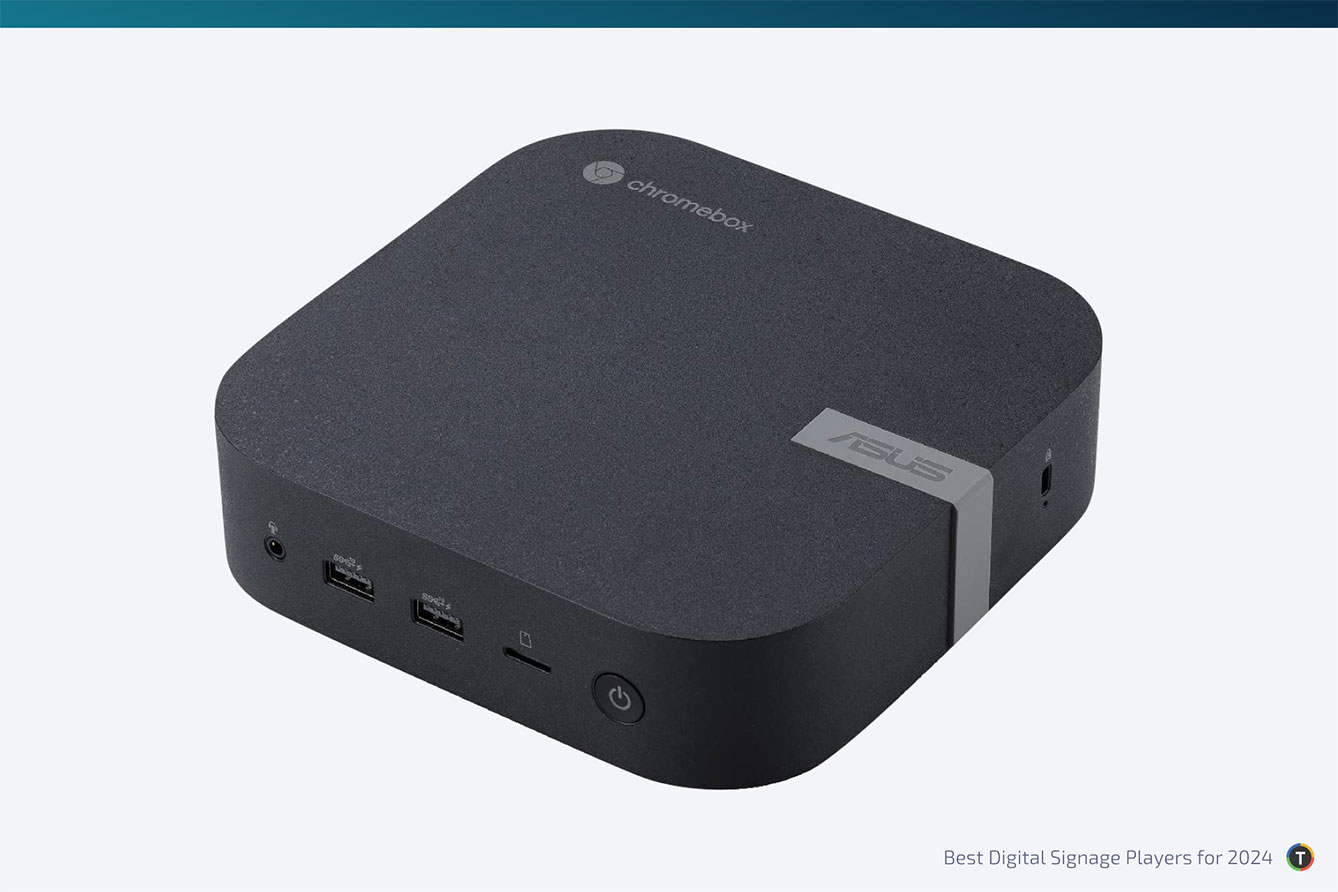
Top choice: ASUS Chromebox 5
ASUS Chromebox 5 is built for performance. Equipped with robust hardware, including ample RAM and a solid-state drive, it ensures smooth and responsive signage operation. Its ability to run 24/7 without faltering makes it a reliable choice for businesses that require uninterrupted digital signage, such as in retail, transportation hubs, or corporate lobbies. The device's array of connectivity options, including multiple display ports, allows for flexibility in setup and is capable of powering 4K displays. Moreover, its compact size does not compromise its performance, making it an excellent option for spaces where a discreet yet powerful media player is needed.
The ASUS Chromebox 5's standout features include its advanced thermal management system, ensuring it remains cool even under continuous operation, and its fast, responsive Chrome OS, which facilitates easy management and deployment of digital signage content. The inclusion of built-in storage provides ample space for media files, while the option for cloud storage integration offers additional flexibility for content management. These features collectively make ASUS Chromebox 5 a top choice for businesses seeking a high-performance signage player.
Pros:
- Designed for continuous 24/7 usage, ensuring reliability in demanding business environments.
- Offers a wide range of connectivity options, including multiple display ports, to accommodate various display setups.
- Compact and efficient design, coupled with powerful performance and ample storage, makes it ideal for business use.
Cons:
- The price point of the Chromebox device may be higher compared to basic digital signage players, reflecting its advanced features and capabilities.
- However, it is fully supported by the TelemetryTV digital signage software, despite being limited to Chrome OS.
- Chromebox devices tend to have a higher total cost of ownership, as their lifespan is commonly short-limited due to artificial obsolescence imposed by Google.
Priced competitively for its class, the ASUS Chromebox 5 offers excellent value for businesses seeking a high-quality digital signage solution.
Pricing Tier: $$$
Purchase Link: ASUS Chromebox 5
Best Touch Screen Tablet for Digital Kiosks
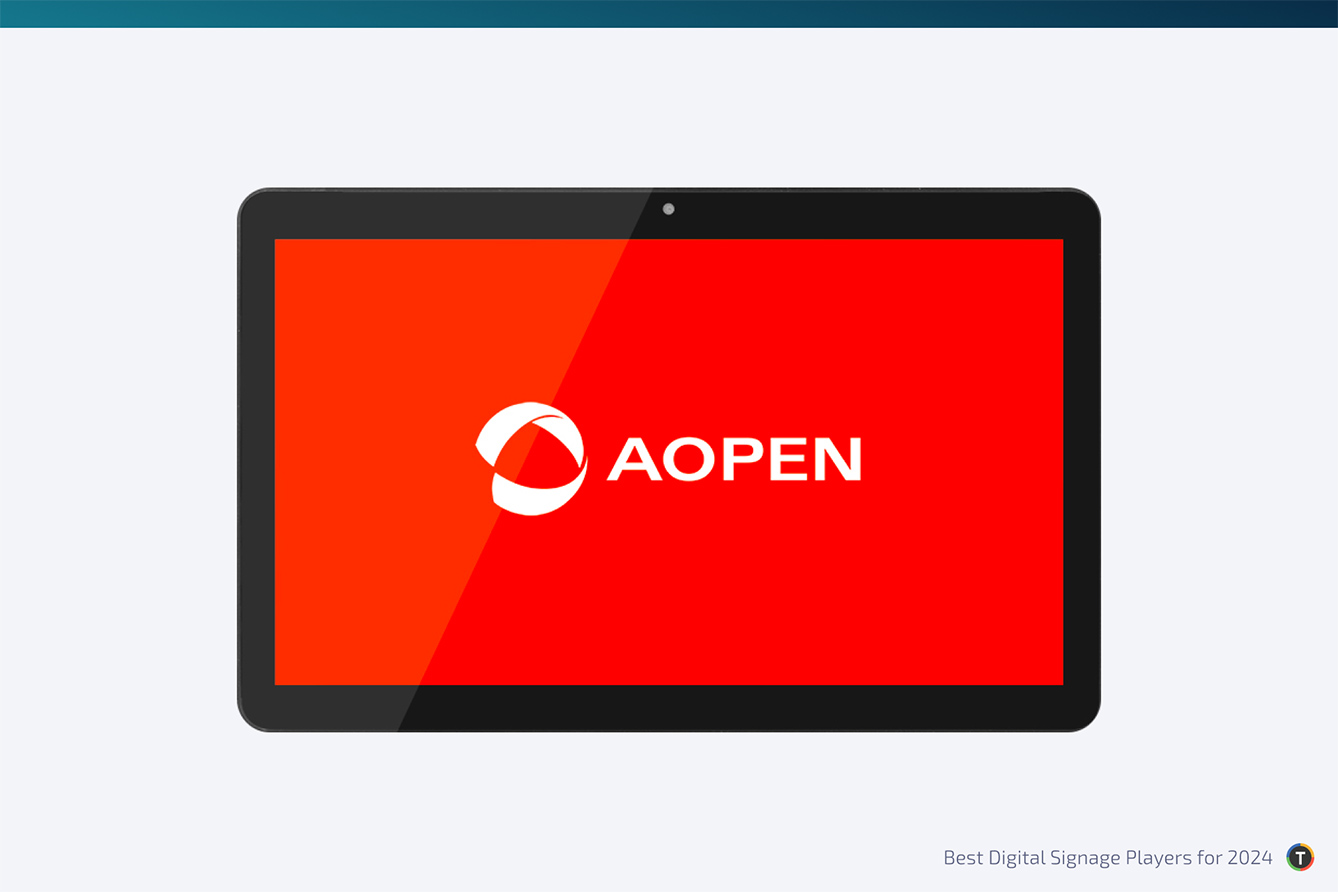
Top choice: AOPEN cTILE 22 Gen2
Tailored for sophisticated digital kiosk solutions, the AOPEN cTILE 22 Gen2 seamlessly integrates into environments that require dynamic interaction. It is ideal for retail self-checkout, menu ordering in QSRs, transportation check-ins, ticketing, meeting room management, and way-finding signage. The standout feature of this device is its large, 21.5" display with Full HD resolution, which ensures that content is not only visible but also engaging and clear, enhancing the user experience in any business setting.
AOPEN cTILE 22 Gen2 is engineered with robust connectivity options. It includes a gig LAN port for stable internet connection, as well as USB and HDMI ports to cater to various digital signage needs. In terms of performance, it is equipped with substantial RAM and an efficient processor, delivering smooth and responsive operation even in demanding applications. Its storage capacity, based on fast SSD drives, is also noteworthy and capable of handling a wide array of applications and media content with ease. The device is designed for continuous 24/7 usage, making it a critical solution for businesses that operate round-the-clock and require reliable digital kiosk.
Pros:
- Exceptional 11-inch Full HD resolution display, ideal for a range of business applications.
- Robust performance with ample RAM and storage, suitable for 24/7 operation.
- Versatile connectivity and display options cater to various business needs.
Cons:
- Screen resolution falls behind solutions available in the personal-use tablet market.
- Continuous operation might necessitate additional cooling solutions in certain setups.
To summarize, the AOPEN cTILE 22 Gen2 is a solid choice for businesses seeking a reliable, high-performance digital signage solution. Its blend of visual clarity, performance, and versatility makes it a valuable asset in any corporate or retail environment.
Pricing Tier: $$$
Purchase Link: AOPEN cTILE 22 Gen2
Best Windows Digital Signage Player
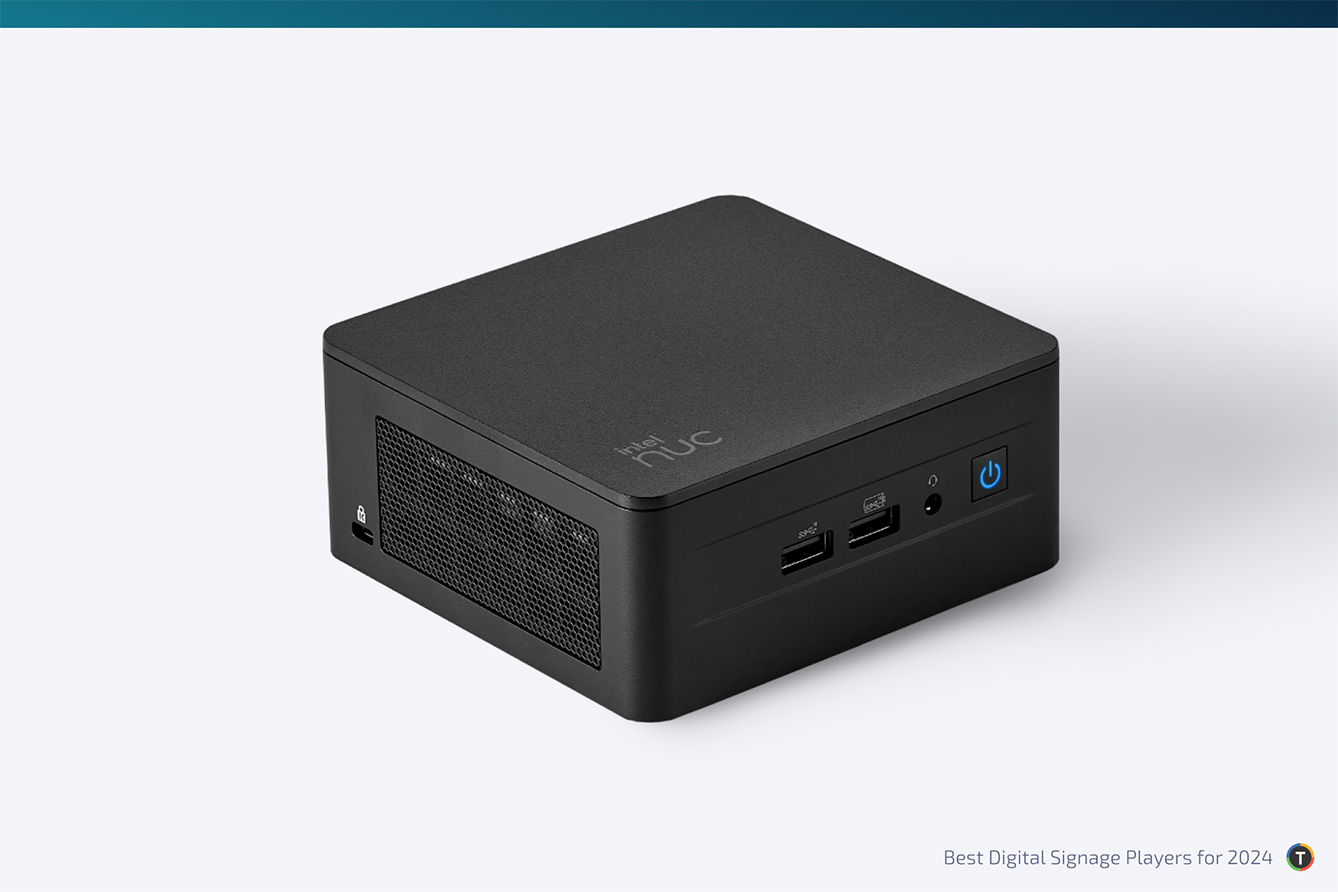
Top choice: Intel® NUC Pro
The Intel® NUC Pro is a reliable Windows media player solution for businesses with existing Windows setups that want to maintain compatibility while seeking robust and versatile options. This compact yet powerful Mini PC is designed for continuous 24/7 operation, making it suitable for a wide range of commercial applications. From single-screen displays to expansive video walls and interactive kiosks, the Intel® NUC Pro is a great choice.
The Intel® NUC Pro is designed for high performance and speed, making it ideal for dynamic digital signage. It supports multiple 4K video channel outputs through HDMI and Thunderbolt™ technology, allowing a single unit to drive multiple displays with different content. This capability is particularly advantageous for creating impactful video walls or managing diverse content across a network of screens. The small form factor of the device enables it to be discreetly mounted behind signage or within kiosks, maintaining a sleek and unobtrusive presence.
Connectivity is a key feature of the Intel® NUC Pro, offering a range of ports and wireless connections typically found in full-size desktop PCs. It includes USB, HDMI, Thunderbolt™ technology, 2.5 Gigabit Ethernet, and Wi-Fi, all packed into its compact frame. This extensive connectivity ensures seamless integration into various digital signage setups, providing flexibility and ease of use. Additionally, the Intel® NUC Pro offers built-in display emulation with virtual displays and persistent display mode, enhancing remote management capabilities and ensuring uninterrupted content delivery.
TelemetryTV provides a native application for Windows that allows users to run the TelemetryTV player application on Windows machines. The app can be used in assigned access mode for kiosk-style installations, enabling the device to launch directly into the TelemetryTV media player.
Pros:
- Continuous 24/7 Operation: Designed for reliability and endurance, it's suitable for demanding commercial environments.
- Multiple 4K Display Support: Capable of driving multiple displays with different content, ideal for diverse digital signage needs.
- Robust Connectivity: Offers a comprehensive range of ports and wireless connections, ensuring versatile and seamless integration.
Cons:
- Price: Higher than other digital signage player options.
- Complexity for Basic Needs: Might be overkill for simple signage applications.
- Size: While compact, it may still require consideration for space in tightly integrated environments.
In summary, the Intel® NUC Pro stands out as a top-tier choice for businesses seeking a powerful, versatile, and reliable digital signage solution. Its ability to support continuous operation, manage multiple high-definition displays, and offer extensive connectivity options makes it a valuable asset in the commercial digital signage landscape.
Pricing Tier: $$$$
Purchase Link: Intel® NUC Pro
Best Linux Digital Signage Player
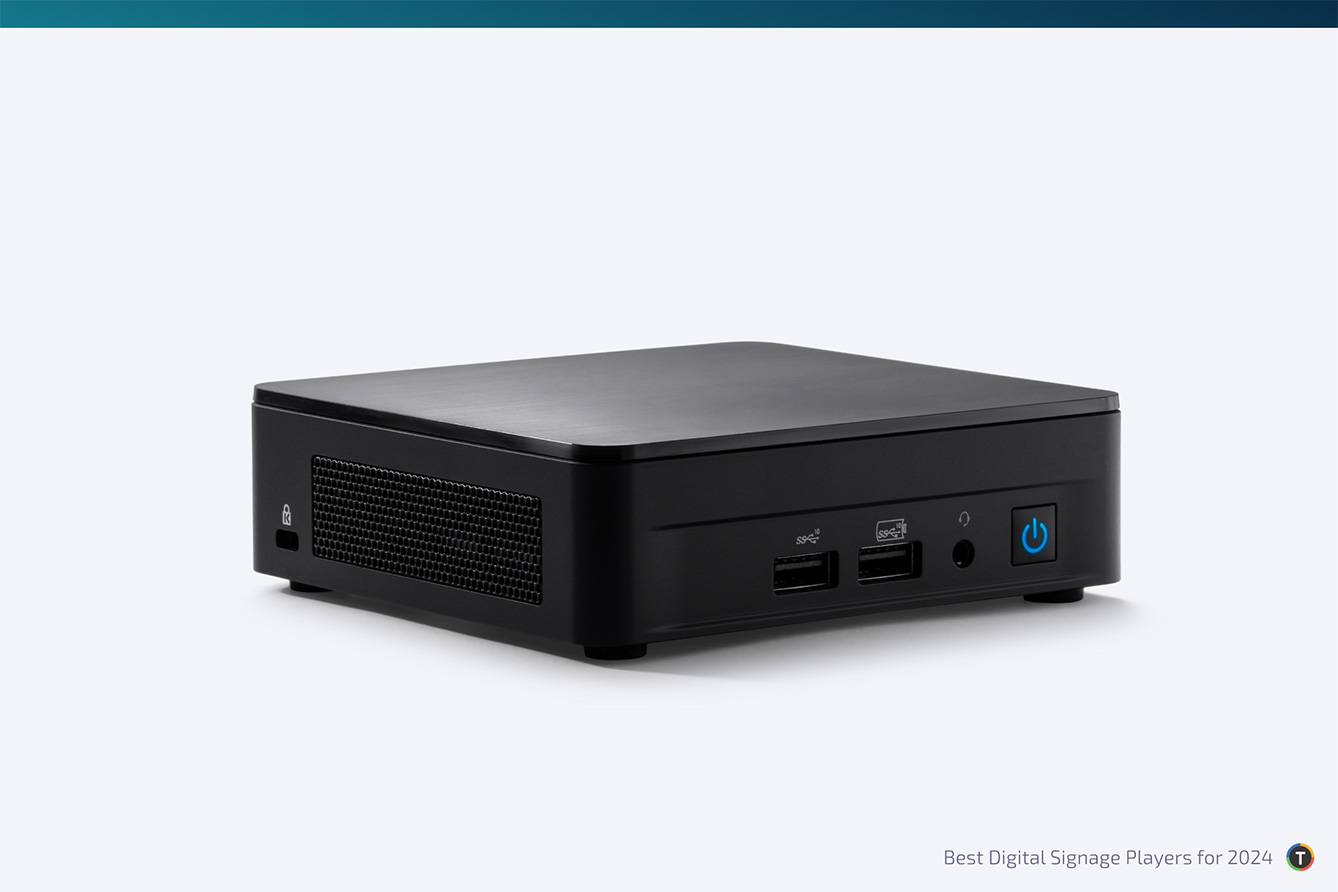
Top choice: Intel® NUC Pro
Here, we would again recommend the Intel® NUC Pro device as it excels when paired with Linux-based operating systems, notably the widely-used Ubuntu, catering to those businesses who prioritize tailored digital signage deployments. It is important to note that leveraging the full potential of this setup necessitates a comprehensive understanding of Linux systems, alongside a commitment of time for meticulous provisioning.
In this context, the TelemetryTV digital signage software platform emerges as an indispensable tool. Its prowess lies in streamlining content management and automating device provisioning on a large scale, effectively reducing administrative workload significantly. This combination of Intel® NUC Pro and TelemetryTV is particularly advantageous for organizations with advanced Linux proficiency, aiming to optimize their digital signage infrastructure.
Pricing Tier: $$$$
Purchase Link: Intel® NUC Pro
Best Apple Digital Signage Player
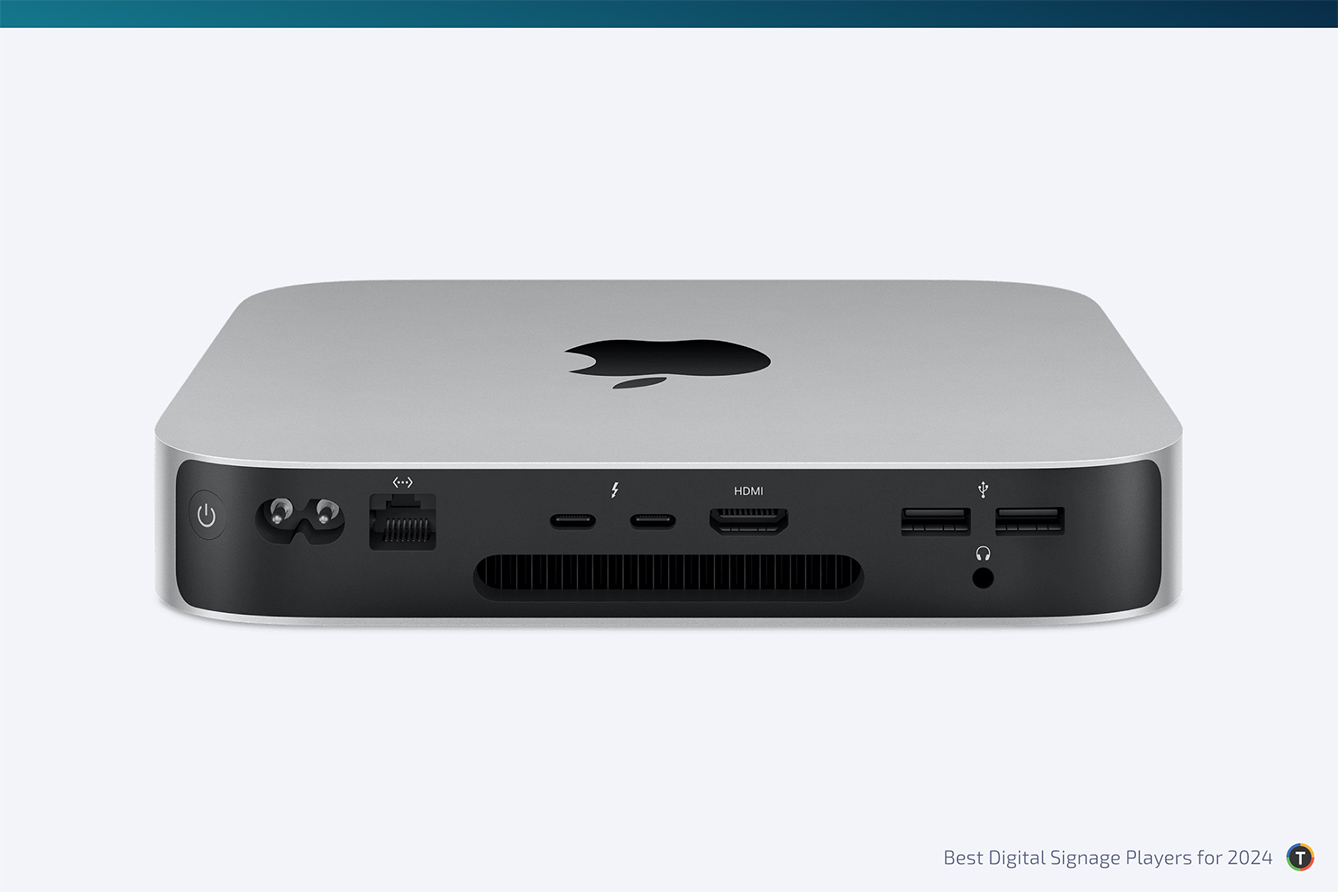
Top choice: Mac mini
The Mac mini is an easy choice for the best digital signage player, especially for Apple enthusiasts. It's a true powerhouse for digital signage, thanks to its Apple Silicon. This device stands out even for the most computing resource-demanding digital signage applications. Its compact design belies its robust performance, making it an excellent option for businesses requiring high-quality display outputs.
The device supports multiple monitors. The M chip Mac mini accommodates up to two 6K/5K displays in the base model, and the higher-tier “Max” chips can support up to three external monitors. This versatility in display connectivity is a significant advantage for businesses that rely on multi-screen setups for their digital signage needs.
Performance-wise, the Mac mini doesn't disappoint. It is designed for continuous usage, making it suitable for 24/7 operations often required in digital signage scenarios. The device's RAM and storage configurations are ample for most business applications, with options catering to varying needs. The Apple Silicon chip ensures low power consumption while maintaining high performance, a critical factor for businesses mindful of energy efficiency and operational costs.
Pros:
- High-Performance Capability: The Apple Silicon chip ensures smooth, efficient operation, even under continuous use.
- Multiple Display Support: With the ability to connect to multiple high-resolution monitors, it's ideal for complex digital signage setups.
- Energy Efficient: The low power consumption of the Mac mini makes it a cost-effective solution over time.
Cons:
- Higher Initial Cost: Starting at $699, it's more expensive than many Chrome and Android alternatives.
- Limited to Apple Ecosystem: Best suited for those already using Apple products and services.
In conclusion, the Mac mini with Apple Silicon is a top-tier choice for businesses seeking a reliable, high-performing digital signage solution. Its ability to support multiple high-resolution displays, combined with its energy efficiency and robust performance, makes it a worthwhile investment, especially for those already within the Apple digital signage ecosystem.
Pricing Tier: $$$$
Purchase Link: Mac mini
Best All-in-One Digital Signage Solution
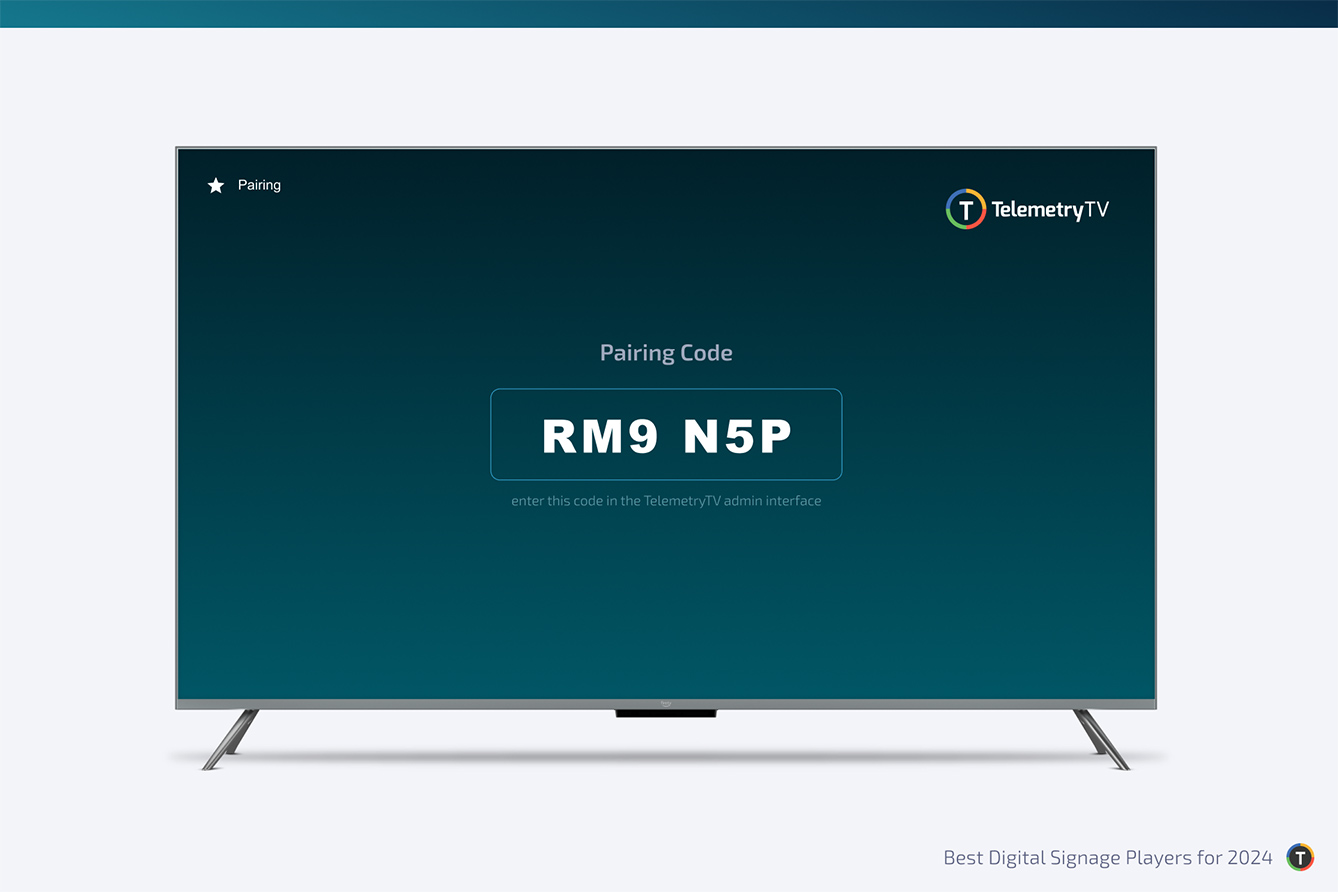
Top choice: Amazon Fire TV Omni Series
The Amazon Fire TV Omni Series is a standout all-in-one solution, especially appealing for organizations with limited budgets and resources for setting up complex digital signage systems. This option simplifies the digital signage setup by integrating the media player directly into the display, eliminating the need for separate purchases and complex configurations. Simply plug in, connect to Wi-Fi, and you're ready to display a variety of engaging content.
The Fire TV Omni Series, particularly notable in its 75-inch model, is ideal for creating digital bulletin boards. Its large screen size ensures visibility even in spacious settings, making it a practical choice for conveying vital information in corporate communication, education, and healthcare. When used together with the TelemetryTV digital signage software, the screen can be split into multiple content zones, each displaying different types of content such as announcements, live streams, weather updates, schedules, and more. This feature is particularly beneficial in settings where diverse information needs to be displayed simultaneously.
In terms of connectivity, the Fire TV Omni Series is equipped with a variety of ports, including HDMI, USB, and more, offering flexibility in connecting different content sources and peripherals. This versatility is crucial in a business environment where varying types of media might need to be displayed. Despite its many advantages, the Fire TV Omni Series does have some limitations. As this device is primarily designed for home usage, it is not intended for continuous 24/7 operation. However, this can be resolved with TelemetryTV's auto power on/off capabilities.
Pros:
- All-in-One Solution: Streamlines setup and reduces costs with integrated media player.
- Large Display Options: Up to 75 inches, ideal for clear visibility in large spaces.
- Content Flexibility: Compatibility with TelemetryTV for multi-zone content display.
Cons:
- Made for Home Usage: Not intended for continuous 24/7 operation
- Average Picture Quality: Adequate but not on par with higher-end models.
- Basic Audio Performance: May require additional investment in external sound systems.
In conclusion, the Amazon Fire TV Omni Series represents a practical and efficient solution for digital signage in business environments, particularly in internal communication use cases. Its large choise of display size options, integrated media player, and content flexibility make it a valuable asset, despite some limitations in picture and audio quality.
Pricing Tier: $$
Purchase Link: Amazon Fire TV Omni Series
Selecting the Best Digital Signage Screen
The cornerstone of selecting an appropriate digital signage screen lies in a thorough analysis of your requirements. Key considerations include the nature of the content, the characteristics of the installation environment, and the intended duration of use. For instance, displays in educational or corporate settings demand versatility to handle a range of content, from 4K videos to interactive applications. In contrast, displays for advertising networks, particularly in remote locations, should prioritize durability, theft protection, and ease of remote management.
The operational duration of the display is a critical factor. Consumer-grade displays are typically designed for up to 8 hours of daily use and may suffice for less intensive applications. However, for round-the-clock operations, professional-grade displays are indispensable. They are engineered for prolonged use, offering enhanced durability and longer warranty periods, thus ensuring reliability and cost-effectiveness in the long run.
Diverse Display Options for Digital Signage
Digital signage displays are diverse, each catering to specific scenarios:
- Professional TVs: Specifically crafted for digital signage, these displays are built for extended use (16/7 or 24/7), offering superior build quality, brightness, and adaptability for outdoor use.
- Tablets: Best suited for interactive settings or close-viewing scenarios, such as kiosks or product displays in retail environments.
- Monitors: Ideal for cost-effective content display in the 17-32 inch range. Beyond this size, TVs become more economical and practical.
- Non-smart TVs: Budget-friendly options for large screens, requiring external media devices to function as digital signage.
- Smart TVs: All-in-one solutions with built-in computing capabilities. It is crucial to evaluate their performance specs, as some may underperform or operate on outdated systems.
Making the Informed Choice
Commercial-grade TVs are specifically designed for digital signage, but advancements in technology have made high-quality consumer-grade TVs suitable for professional setups as well. Ultimately, you should choose a display that aligns with your operational needs, ensuring effective content delivery and long-term durability in your specific business context.
You can find our top picks for different display options by reading our comprehensive guide to choosing digital signage screens.
The Most Advanced Digital Signage Player Operating System
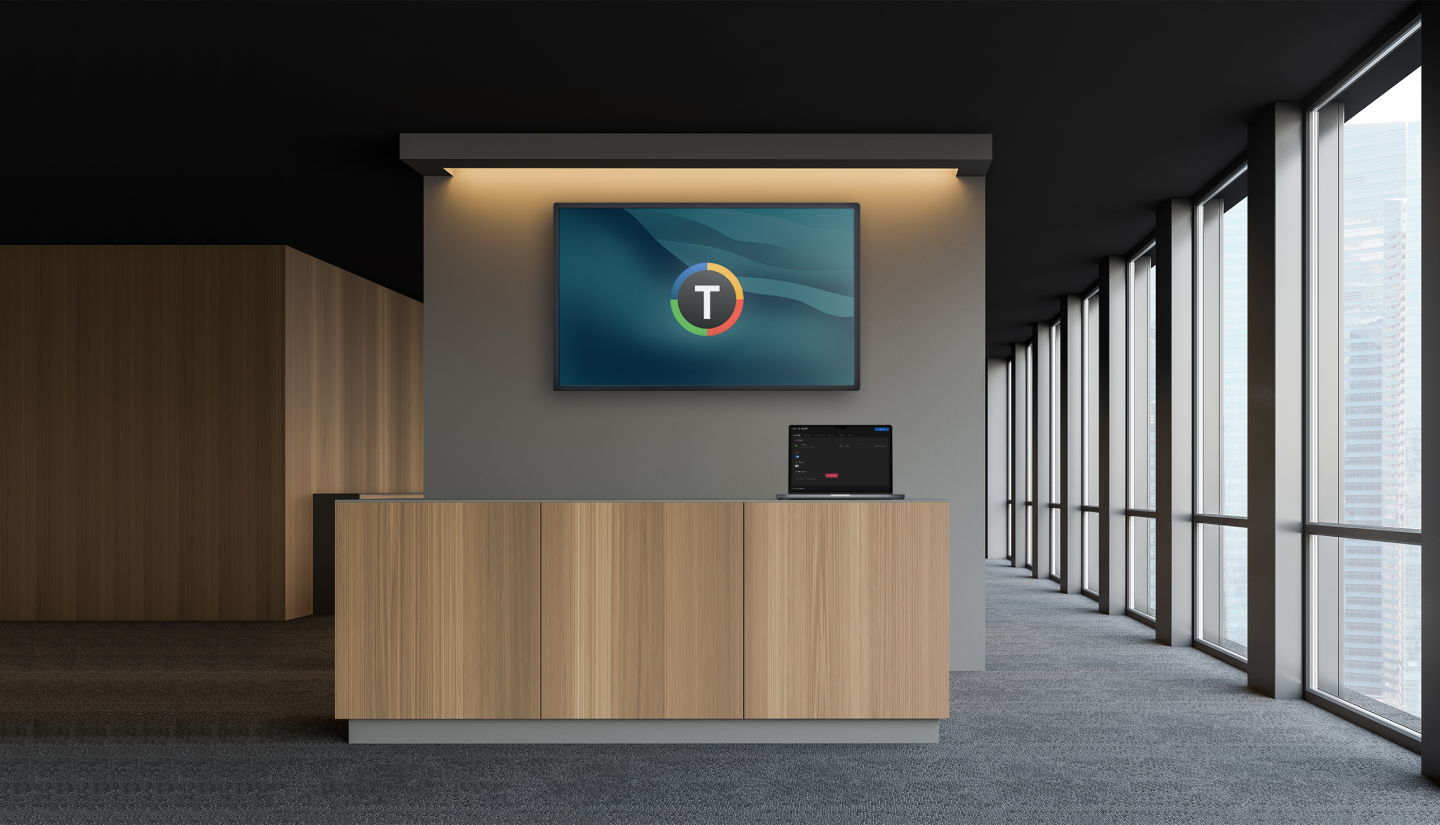
TelemetryOS is a digital signage-first operating system optimized for high-definition videos, web apps, network stability, and minimal total cost of ownership. Over 80% of TelemetryTV’s new customers choose TelemetryOS as their preferred system for running TelemetryTV—including Databricks, Chopt, and UC Berkeley.
TelemetryOS Advantages
While the TelemetryTV application offers comprehensive features and high performance across all its supported platforms, TelemetryOS, purpose-built for media players, has some large advantages over Android, ChromeOS, Windows, MacOS, or PWAs:
Low TCO
Our user data shows TelemetryOS reduces downtime by 67% and requires 56% less time spent on device maintenance due to automatic security patching and software updates compared to other OSs.
Stability and Security
TelemetryOS is a stripped-down and hardened version of Ubuntu 20 LTS, a secure and stable OS offering extended support until 2030 and no artificial obsolescence. Its lean architecture and small surface area ensure high performance on inexpensive hardware.
Turnkey Hardware
TelemetryOS comes available on a variety of hardware, including PC sticks, media player boxes, and RPi-powered TVs that come bundled with TelemetryOS for fast and easy provisioning of many devices at once. You can also self-install an image on an Intel or RPi mini PC with an ISO installer.
Exclusive Features.
TelemetryOS enables advanced features like AI audience analytics for DooH advertising, USB and GPIO access via SDK, GUI for network connectivity configuration, IPTV, live video streaming, and custom web app SDK.
Consider using TelemetryOS for your digital signage deployments to cut down your network's total cost of ownership, get exceptional performance, enterprise-grade security and stability, and access features not available with other operating systems.
Powerful and Intuitive Cloud-Based Digital Signage Software
After selecting the optimal digital signage player option, the next critical step is to equip it with software that is not only powerful and reliable, but also simplifies device provisioning and maintenance, especially for large-scale business environments.
That's where TelemetryTV comes in. With TelemetryTV's multi-platform support, you can connect any option from this guide knowing that TelemetryTV will work perfectly with the device.
TelemetryTV's Device Management Capabilities
Real-Time Device Health & Stats Reporting
This feature provides immediate insights into the health and performance of each signage player. Access critical statistics like CPU and cache usage, along with error logs. Receive email alerts if devices go offline, ensuring you can respond quickly and reduce interruptions, enabling proactive maintenance and ensuring optimal performance of your digital signage network.
Automatic Device Provisioning
With the ability to automatically provision tens to thousands of devices simultaneously, TelemetryTV significantly reduces the time and effort required to set up and expand your digital signage network. This feature is particularly beneficial for large-scale deployments, ensuring consistency and efficiency across all devices.
Serial Port Commands (RS-232 & HDMI CEC)
This feature enables users to schedule and trigger essential hardware events such as powering displays on or off, adjusting volume, and selecting inputs. You can change input sources remotely. You can schedule your screens to power on or off at specific times, aligning with business hours or content schedules. You can make volume adjustments remotely, ensuring the audio levels are always appropriate for the setting and time of day.
Other Capabilities
Explore TelemetryTV's device management tools further by watching this video.
Get Started with TelemetryTV Now
Sign up for a free 14-day trial of TelemetryTV today to see how it all works directly. Or, request a demo to get a firsthand look at our solution for managing digital kiosk devices, content, and custom web applications.
Visual Communication. Everywhere.
Get started for free. No credit card required.

